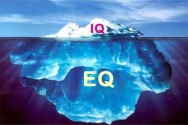 To give the book its full title ‘The New Leaders – Transforming the art of leadership into the science of results’ is rather grand and contribute little. I ordered the book after stumbling upon Daniel Goleman’s research here and there and I found these summaries very readable and interesting. Sadly, although Emotional Intelligence (EI) is an interesting topic for commentary (as shown by Malcolm Gladwell’s) when its the focus on an entire book, it can became a little repetitive. This said, I would still recommend the book.
To give the book its full title ‘The New Leaders – Transforming the art of leadership into the science of results’ is rather grand and contribute little. I ordered the book after stumbling upon Daniel Goleman’s research here and there and I found these summaries very readable and interesting. Sadly, although Emotional Intelligence (EI) is an interesting topic for commentary (as shown by Malcolm Gladwell’s) when its the focus on an entire book, it can became a little repetitive. This said, I would still recommend the book.
Goleman presents a strong case for the increasing importance of EI in leadership, particularly as you journey up the leadership ladder.
The singular talent that separates the most successful CEOs apart from others turned out to be a critical mass of emotional intelligence competences. The most successful CEOs spent more time coaching their senior executives, developing them as collaborators and cultivating personal relationships with them.
Hence, looking for combined leadership and EI commentary seems a worthwhile pursuit, if I could add a third valuable, education, that would be right on the money.
Again, not wishing to mislead or disappoint you, there is only one comprehensive education example, a review of leadership in UK schools (page 107). Goleman reports that in 69% of high performing school, the headteacher exhibited four or more resonance-building leadership styles. In 66% of the low performing schools, the head relied on just on or two leadership styles, typical dissonant ones.
In summary, flexible leadership generally leds to a positive climate. Whereas a headteacher who is rigid, stuck in command and control mode, left the teachers demoralised. Ground breaking? Revolutionary? Perhaps not.
The good news, according to Goleman is that Leadership is learnable, the process is not easy, it takes time and commitment, but it has the potential to be invigorating. What is more, Goleman offer the typical five step process;
Step one, discovering yourself. Who you want to be, before you can move onto step two, discovering of the real you, your strengths and weaknesses. The third step is planning the learning agenda before step four, experimenting and practicing new behaviours to the point of mastery. Finally developing the supportive trusting relationships that make change possible.
IMHO the ‘Leading from the Middle’ programme introduced me to a range of new techniques to experiment with, but sadly, most of my leadership development is ‘on the job.’ I am not sure that education does that good of job of developing its leadership potential.
The final I point I raise is a Goleman’s research statistic,
EI contribute 80-90% of the competencies that distinguish outstanding from average leaders.
If this is accurate, or even nearly accurate, reviewing and developing my own EI is imperative. Encouraging the the middle leaders I work with, even more so.
